The State of Vermont has a rich history, and the history of forestry and forest management in the state is no exception. Check out the links to historical documents and photos as well as the timeline of important events in the history of forestry in Vermont.
Historical Publications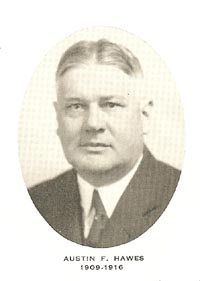
History of Forestry in Vermont, 1916 by Austin F. Hawes
History of Forestry in Vermont: 1909-1959 by Perry H. Merrill
Forestry in Vermont, 1947 by Perry H. Merrill
Timeline of Forestry in Vermont
1738-1739- Vermont's first primitive sawmill is built in Westminster.
1820- The advent of Vermont's iron industry creates a new demand for charcoal. In Glastenbury alone, 10,000 bushels of charcoal were burned for smelting iron ore in 1820.
1840- The census of 1840 shows 1,081 sawmills in Vermont.
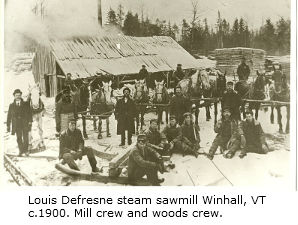 1870- Burlington grows into one of the largest lumber processing centers in the United States, importing over 150 million board feet of lumber annually.
1870- Burlington grows into one of the largest lumber processing centers in the United States, importing over 150 million board feet of lumber annually.
1886- The first Arbor Day in Vermont is proclaimed by Governor Samuel E. Pingree.
1903- Devastating fires burn over 5,000 acres in VT
1904- A Commissioner of Forestry was appointed by the Governor in 1904 to oversee the new fire warden system.
1906-1907- Legislation passes to create the State Tree Nursery at Centennial Field in Burlington.
1908- 106 individual forest fires scorch nearly 16,000 acres.
1909- Austin F. Hawes is appointed as Vermont’s first State Forester, and the first state forest, L.R. Jones, is purchased in Plainfield, which marks the creation of the Division of Forestry.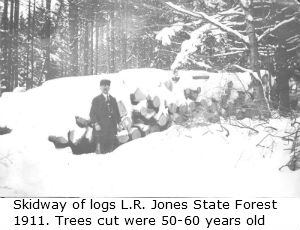
1912- 8,000 spruce seedlings ordered from Europe for planting at Downer State Forest are lost when the RMS Titanic sinks. Mr. Elmer A. Darling builds the first fire tower on Burke Mountain.
1915- Last saw log drive is conducted on the Connecticut River.
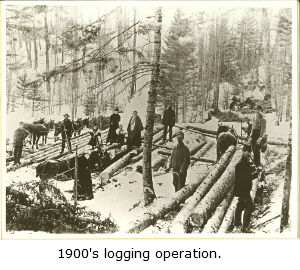 1917- Legislature abolishes Division of Forestry and transfers the duties of the State Forester to the Commissioner of Agriculture.
1917- Legislature abolishes Division of Forestry and transfers the duties of the State Forester to the Commissioner of Agriculture.
1922- The State Tree Nursery moves from Burlington to Essex.
1923- The Vermont Legislature creates a Forest Service and the position of Commissioner of Forestry.
1924- Mrs. Frances Humphrey donates land that will become the first State Park, Mt. Philo.
1925- The Vermont Legislature approves the purchase of land to help establish the Green Mountain National Forest.
1929- Public forest programs distribute fuelwood to those in need.
1932- The Green Mountain National Forest is established.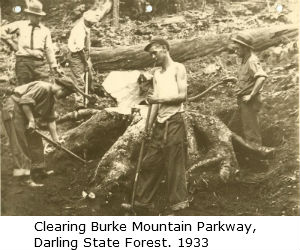
1933- Civilian Conservation Corps (CCC) is established. Between 1933 and 1941, State Forester, Perry Merrill enlists the help of the CCC to cut ski trails, build roads and increase access to state lands thoughout Vermont.
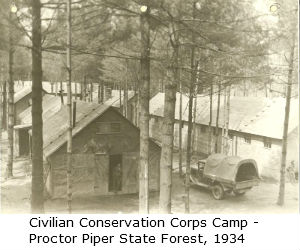 1938- A hurricane destroys sugarbushes, timberland and fire towers.
1938- A hurricane destroys sugarbushes, timberland and fire towers.
1941- The Norris-Doxey Farm Forestry Act leads to the establishment of the County Forester program in Vermont.
1948- The last pulpwood drive in conducted on the Connecticut River.
1949- The sugar maple is designated as state tree of Vermont.
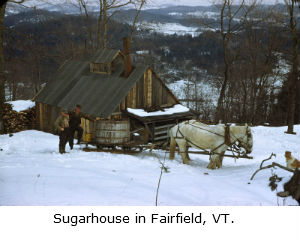 1955- The Vermont Legislature establishes the Department of Forests and Parks, which later (1979) becomes the Department of Forests, Parks and Recreation (FPR).
1955- The Vermont Legislature establishes the Department of Forests and Parks, which later (1979) becomes the Department of Forests, Parks and Recreation (FPR).
1956- Vermont’s first tree farm - privately-owned forest managed for wood, water, wildlife and recreation - is established at the Mt. Tom Forest in Woodstock. Nine other tree farms were also established that day.
1958- FPR helps re-introduce the fisher to protect forests from porcupines.
1961- 10,000,000 trees are planted thanks to the Soil Bank Program.
1969- The George D. Aiken Maple Research Laboratory is established by the University of Vermont.
1970- The Agency of Environmental Conservation is formed by combining three departments.
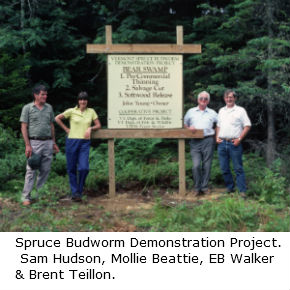 1975- The spruce budworm is discovered, and its activity eventually results in the mortality of 85,000 acres of balsam fir trees.
1975- The spruce budworm is discovered, and its activity eventually results in the mortality of 85,000 acres of balsam fir trees.
1978- Vermont passes the Use Value Appraisal Law, lead to the conservation of 1.5 million acres of forest land.
1979- The Department of Forests and Parks is renamed the Department of Forests, Parks and Recreation.
1981- The first wood-fired electric generating plant, McNeil Station located in Burlington receives approval from the Vermont Public Service Board.
1985- Mollie H. Beattie becomes FPR’s first female Commissioner.
1985- The Vermont Youth Conservation Corps is created, modeled after the Civilian Conservation Corps of the 1930's.
1987- Calais Elementary School becomes the first school to successfully convert their heating system to wood chip heat.
1988- Diamond International Corporation puts 1 million acres of forest land up for sale in northern Vermont, New Hampshire, Maine and New York. The risk that the sale would change the character of these lands caused Congress to initiate the Northern Forest Lands Study and estabish the Northern Forest Lands Council as a body to develop policy alternatives to help maintain traditional use and the quality of life in the Northern Forest.
1990- The Vermont Monitoring Cooperative is founded to help coordinate forest ecosystem research and monitoring efforts between the FPR, the University of Vermont and the Green Mountain National Forest.
1990- The Forest Biology Laboratory is established in Waterbury.
1991- Vermont establishes an Urban and Community Forestry Program.
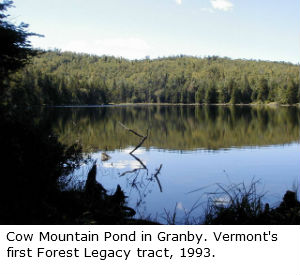 1993- Vermont has the nation’s first Forest Legacy tract, Cow Mountain Pond in Granby, a premier land protection program.
1993- Vermont has the nation’s first Forest Legacy tract, Cow Mountain Pond in Granby, a premier land protection program.
1997- The Vermont Legislature passes Act 15: An Act to Regulate the Heavy Cutting of the Timber Resources. This law was the first of its kind in Vermont and required approval for "heavy" cuts on areas over 40 acres in size.
1998 - Vermont’s only National Park, Marsh-Billings-Rockefeller National Historic Park is opened.
1998- A region wide ice storm affects nearly 1 million acres of forest in Vermont.
2002- The amount of forestland enrolled in the Use Value Appraisal program reaches 1.25 million acres.
2005- The Trees for Local Communities cost-share grant program exceeds 1 million in funding to municipalities and volunteer organizations across the state. The grants are now called Caring for Canopy.
2006- The Watershed Forestry Program is established under the Governor's Clean and Clear Initiative.
2007- The percentage forest cover drops from 79% to 75%, the first decline seen since the peak of land clearing in the mid-1800's.
2008- The Wood Warms program offers subsidized firewood to low-income Vermonters.
2009 - The Department of Forests, Parks and Recreation celebrates its first 100 years supporting Vermonters in their stewardship of forests.
